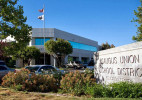[KHTS] – Longtime Canyon Country resident Jennifer Trosper is one of 440 Jet Propulsion Lab employees who makes the commute from the Santa Clarita Valley to the laboratory in Pasadena every weekday.
 JPL is administered by CalTech and funded through NASA, and Trosper is currently the deputy project manager for the Curiosity rover, which is seeking evidence of Mars’ ability to sustain life.
JPL is administered by CalTech and funded through NASA, and Trosper is currently the deputy project manager for the Curiosity rover, which is seeking evidence of Mars’ ability to sustain life.
Trosper first came to the Santa Clarita Valley 15 years ago with her husband, who is a military service member stationed at Edwards Air Force base.
“Canyon Country is exactly halfway between the base and Pasadena,” she said. “I know a lot of ‘JPLers’ have chosen Santa Clarita as their home… I love Santa Clarita.”
Raised on a farm in Ohio, Trosper said she was inspired to begin her career because of her dad, who worked in the space industry in the 50s.
“I actually raised animals and I worked in the fields,” she said. “(My parents) basically didn’t set any limits on the farm girl from Ohio.”
From Ohio, Trosper moved to Massachusetts to attend MIT.
“The thing I really liked about MIT is that it was hardcore engineering. We were learning how to problem solve, not just solving problems, so there was little bit of a difference in that,” she said. “The other thing I love about MIT is they had a lot of sports. I was able to play volleyball (and) I was the setter… There was just a lot of opportunity to do a lot of things, which was wonderful.”
Her senior year, Trosper considered joining the Peace Corps or going into the CIA, but after interviewing with JPL, she made the decision to make the move to California to begin her NASA career.
 “There are lots of different systems on a spacecraft,” she said. “I just started working in each of the different areas… I did a lot of things so that eventually, I became system engineer where you can put all the pieces of the spacecraft together.”
“There are lots of different systems on a spacecraft,” she said. “I just started working in each of the different areas… I did a lot of things so that eventually, I became system engineer where you can put all the pieces of the spacecraft together.”
Trosper joked about the stressful nature of working with rovers on missions to Mars during an interview with Kyle Jellings on KHTS AM-1220:
“The time it takes for a radio signal to get from Earth to Mars and back from Mars to Earth… We call it the seven minutes of terror. By the time you get any information from Mars, it’s already happened.”
When the Curiosity rover first landed on Mars several years ago, a new technology called a sky crane was used instead of the traditional air bag system.
“Basically it was like a helicopter that placed (the rover) carefully on the ground. It was extremely exciting to see,” she said. “It was the first step in some of the new technologies we need to land people on Mars eventually.”
The rover landed in a crater and has been driving toward a mountain that appears to have built up in the crater’s center, she said.
“A mountain that built up over time is basically like a history book of the geology of the surface of Mars. The rover is like our eyes and hands and feet that goes to read this history book that we see there on the surface of Mars.”
Curiosity arrived at the mountain, which has been named Mount Sharp, approximately one month ago and is currently investigating its foothills.
“Prior to that we actually met the mission criteria: to find out if Mars had ever been habitable,” Trosper said. “Many billions of years ago, (microorganisms) could have lived on the surface of Mars, so now we’re trying to figure out where the best places to preserve that information would be.”
Like this:
Like Loading...
Related




 Tweet This
Tweet This Facebook
Facebook Digg This
Digg This Bookmark
Bookmark Stumble
Stumble RSS
RSS




























REAL NAMES ONLY: All posters must use their real individual or business name. This applies equally to Twitter account holders who use a nickname.
0 Comments
You can be the first one to leave a comment.